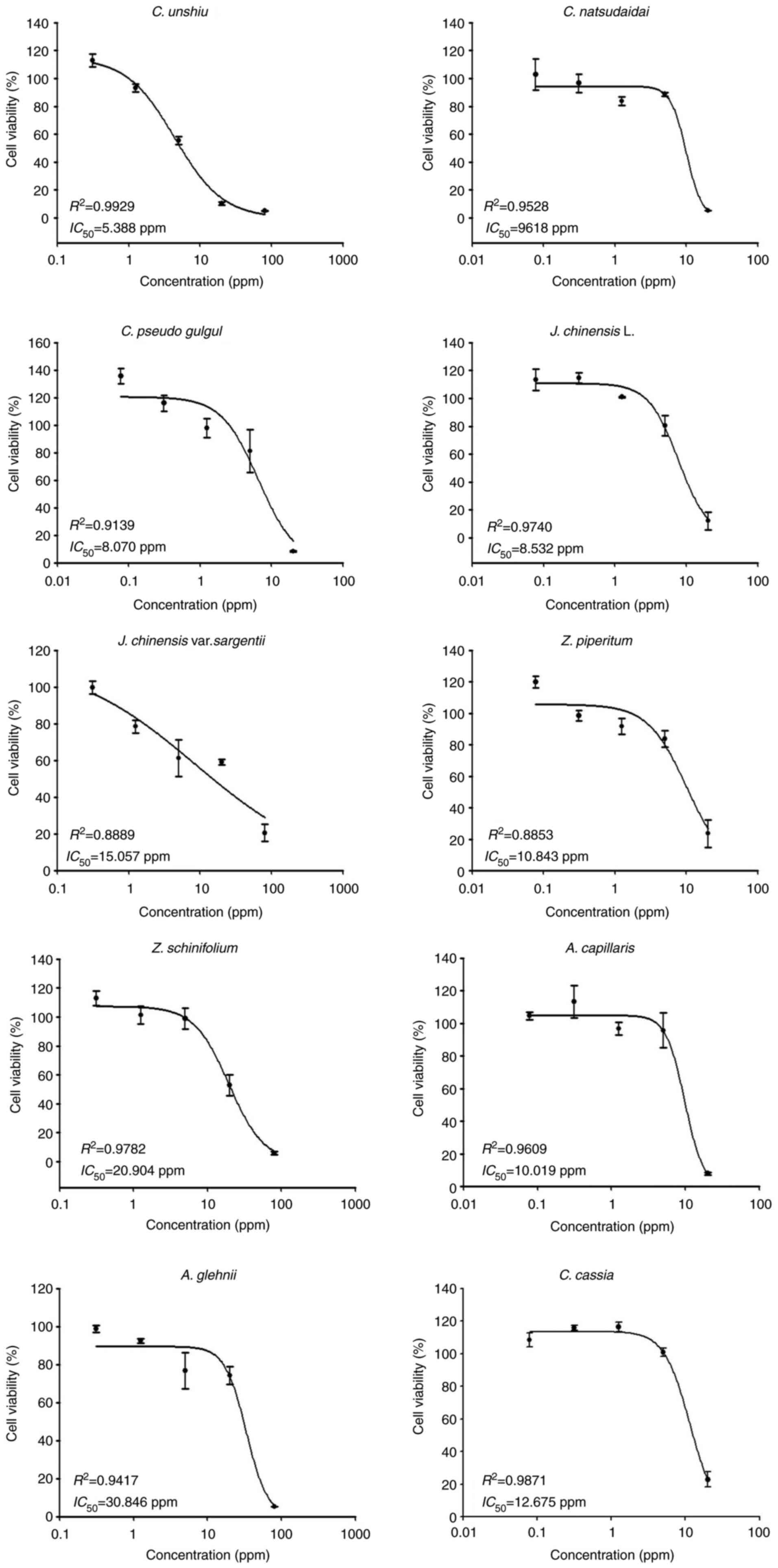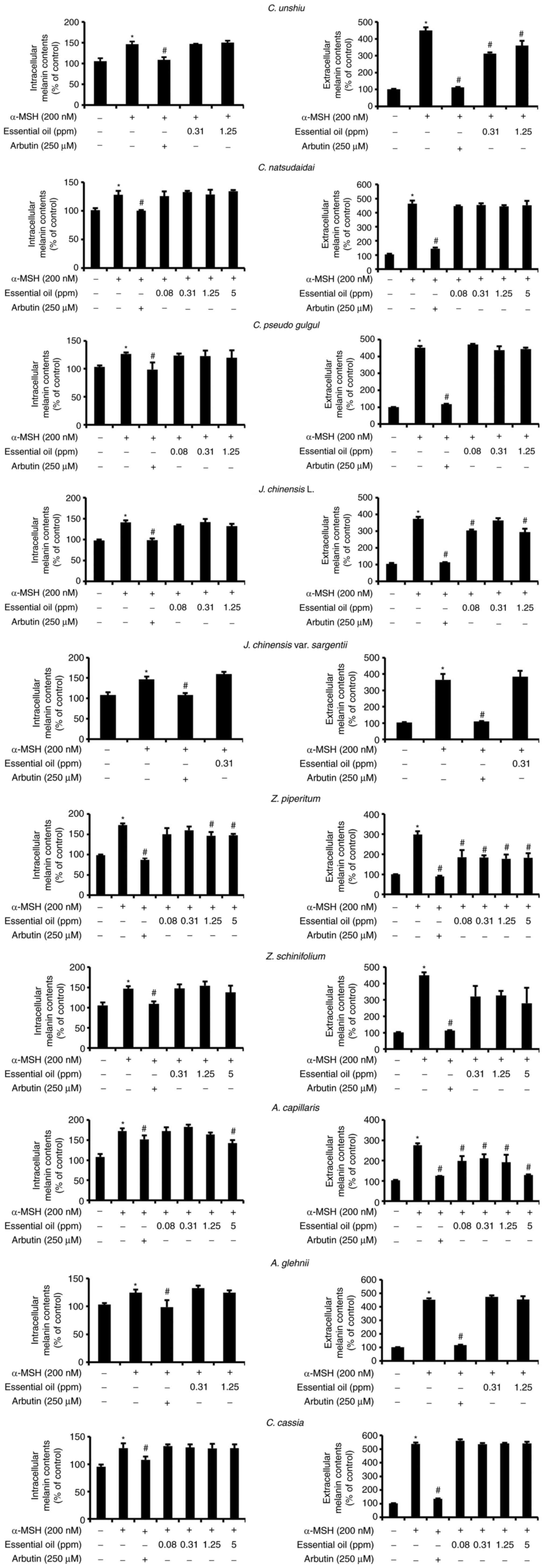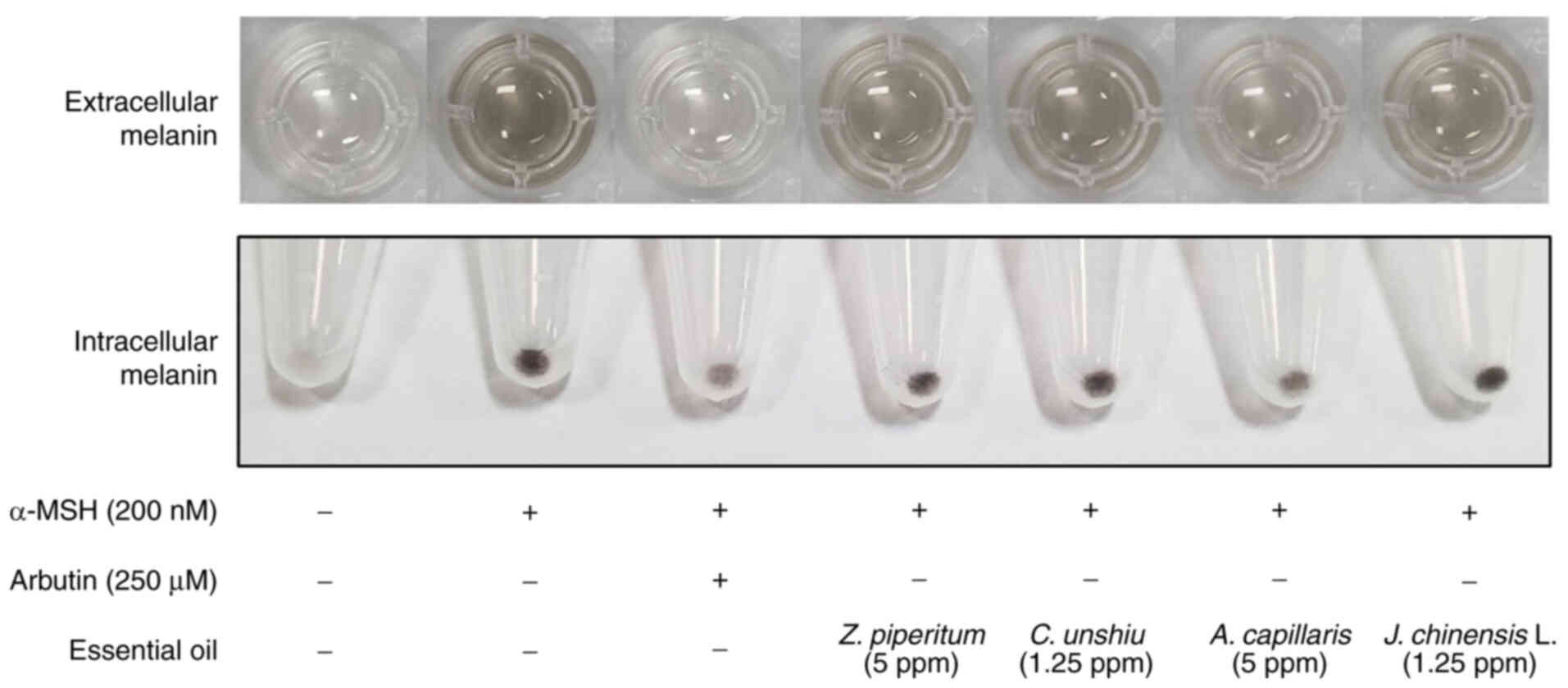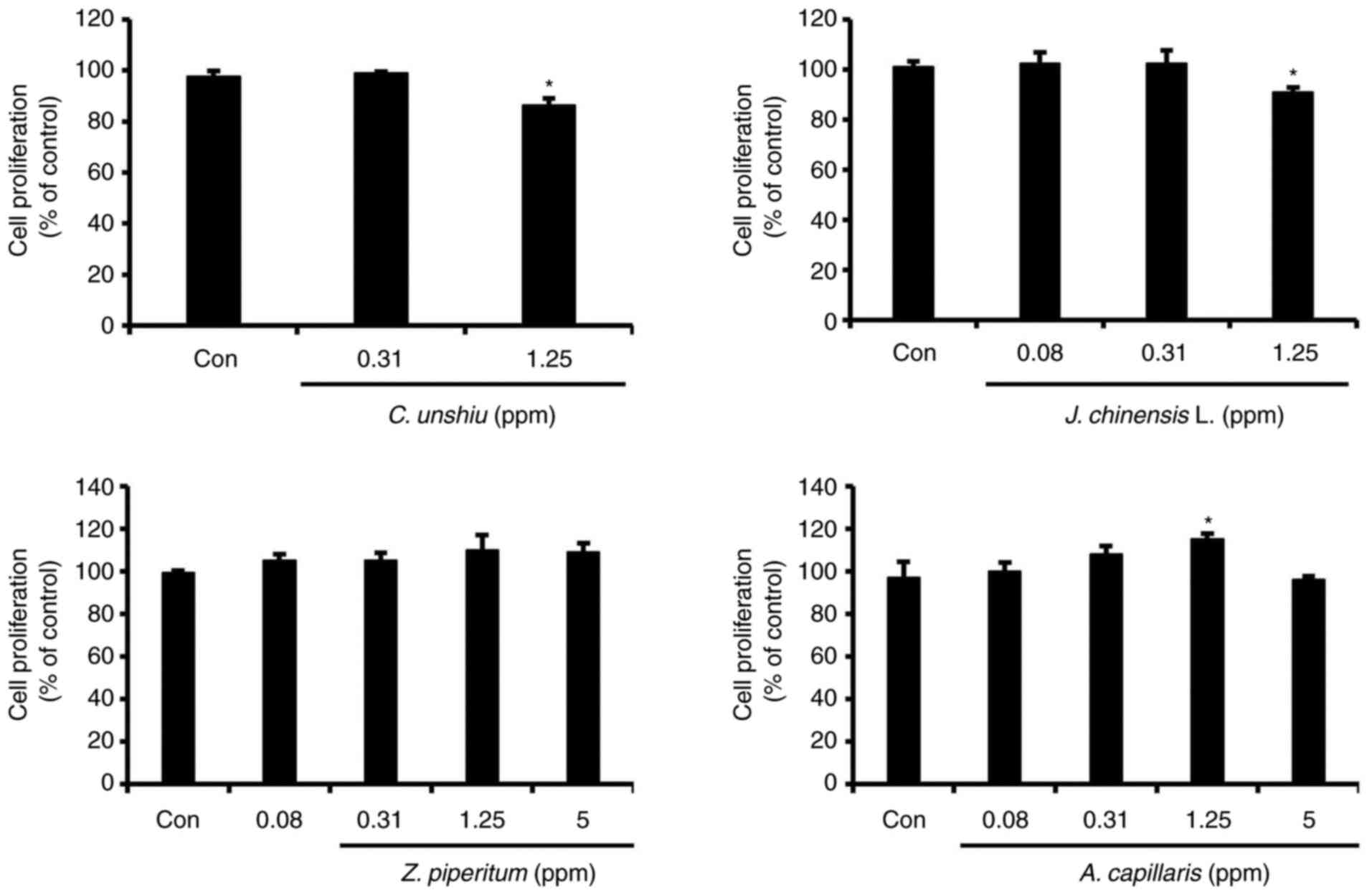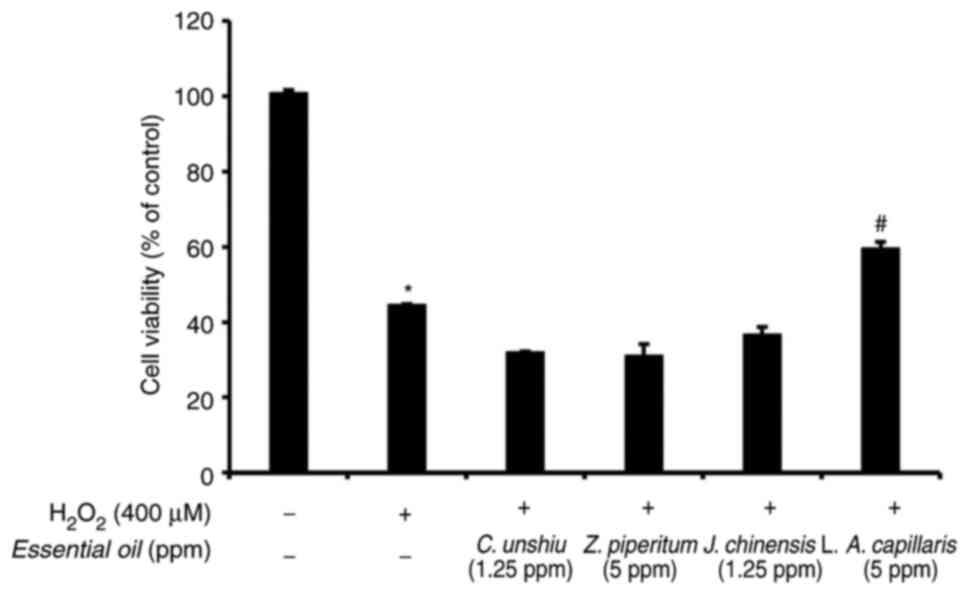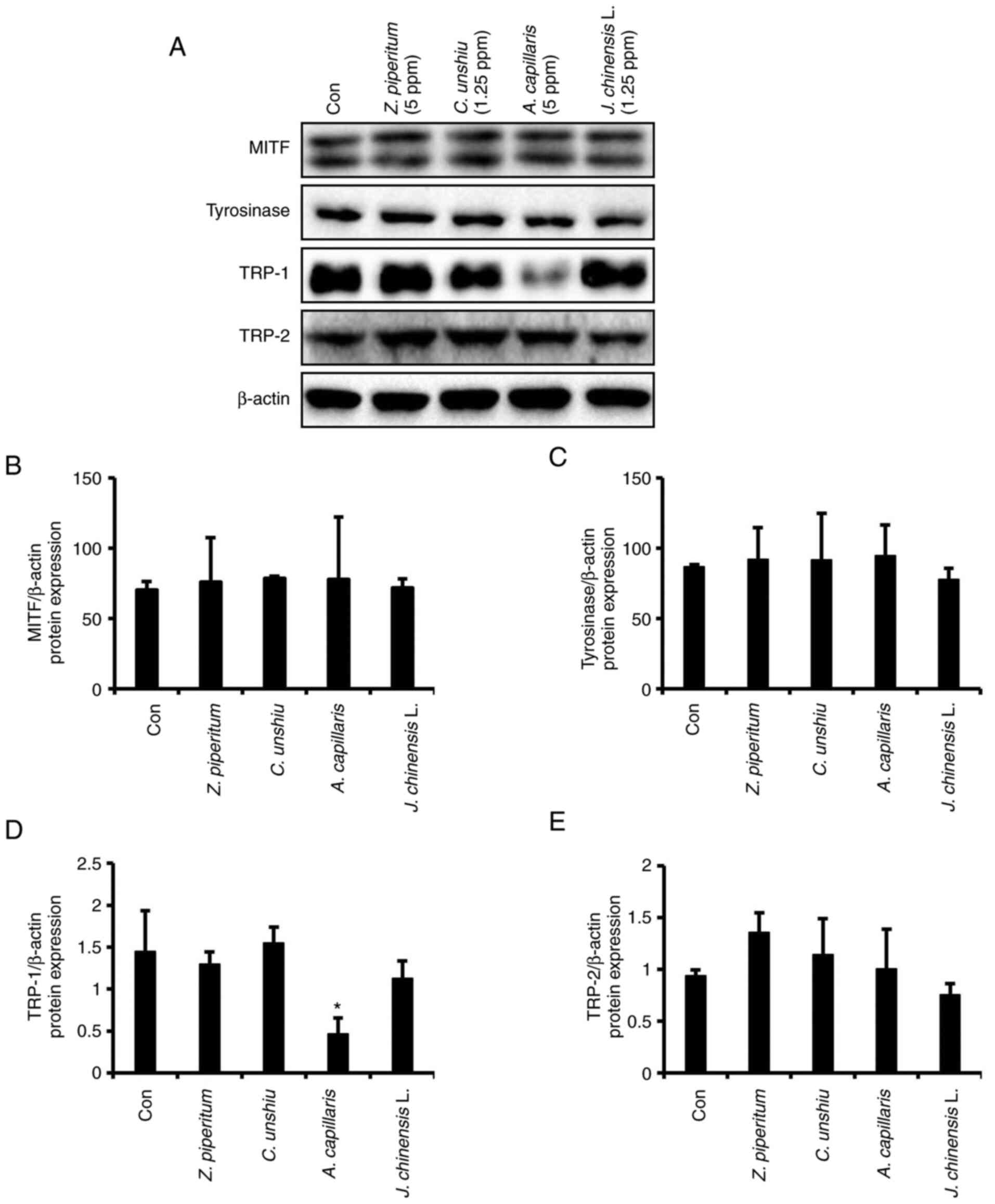|
1
|
Tayarani-Najaran Z, Akaberi M, Vatani M
and Emami SA: Evaluation of antioxidant and anti-melanogenic
activities of different extracts from aerial parts of Nepeta
binaludensis Jamzad in murine melanoma B16F10 cells. Iran J Basic
Med Sci. 19:662–669. 2016.PubMed/NCBI
|
|
2
|
Slominski A, Tobin DJ, Shibahara S and
Wortsman J: Melanin pigmentation in mammalian skin and its hormonal
regulation. Physiol Rev. 84:1155–1228. 2004. View Article : Google Scholar : PubMed/NCBI
|
|
3
|
Slominski A, Zmijewski MA and Pawelek J:
L-tyrosine and L-dihydroxyphenylalanine as hormone-like regulators
of melanocyte functions. Pigment Cell Melanoma Res. 25:14–27. 2012.
View Article : Google Scholar : PubMed/NCBI
|
|
4
|
Wang L, Oh JY, Kim YS, Lee HG, Lee JS and
Jeon YJ: Anti-photoaging and anti-melanogenesis effects of fucoidan
isolated from Hizikia fusiforme and its underlying mechanisms. Mar
Drugs. 18:4272020. View Article : Google Scholar : PubMed/NCBI
|
|
5
|
Rok J, Otręba M, Buszman E and Wrześniok
D: Melanin-from melanocyte to keratinocyte, that is how melanin is
transported within the skin. Ann Acad Med Siles. 66:60–66.
2012.
|
|
6
|
Slominski A, Wortsman J, Luger T, Paus R
and Solomon S: Corticotropin releasing hormone and
proopiomelanocortin involvement in the cutaneous response to
stress. Physiol Rev. 80:979–1020. 2000. View Article : Google Scholar : PubMed/NCBI
|
|
7
|
Slominski AT, Zmijewski MA, Skobowiat C,
Zbytek B, Slominski RM and Steketee JD: Sensing the environment:
Regulation of local and global homeostasis by the skin's
neuroendocrine system. Adv Anat Embryol Cell Biol. 212:vvii, 1,
115. 2012.PubMed/NCBI
|
|
8
|
Otręba M, Buszman E, Miliński M and
Wrześniok D: Hypomelanoses transmitted from generation to
generation. Postepy Hig Med Dosw (Online). 68:1081–1090. 2014.(In
Polish). View Article : Google Scholar : PubMed/NCBI
|
|
9
|
Otręba M, Miliński M, Buszman E, Wrześniok
D and Beberok A: Hereditary hypomelanocytoses: the role of PAX3,
SOX10, MITF, SNAI2, KIT, EDN3 and EDNRB genes. Postepy Hig Med Dosw
(Online). 67:1109–1118. 2013.(In Polish). View Article : Google Scholar : PubMed/NCBI
|
|
10
|
Goswami P and Sharma HK: Skin
hyperpigmentation disorders and use of herbal extracts: A review.
Curr Trends Pharm Res. 7:81–104. 2020.
|
|
11
|
Burger P, Landreau A, Azoulay S, Michel T
and Fernandez X: Skin whitening cosmetics: Feedback and challenges
in the development of natural skin lighteners. Cosmetics. 3:362016.
View Article : Google Scholar
|
|
12
|
Pollock S, Taylor S, Oyerinde O,
Nurmohamed S, Dlova N, Sarkar R, Galadari H, Manela-Azulay M, Chung
HS, Handog E and Kourosh AS: The dark side of skin lightening: An
international collaboration and review of a public health issue
affecting dermatology. Int J Womens Dermatol. 7:158–164. 2020.
View Article : Google Scholar : PubMed/NCBI
|
|
13
|
Cestari TF, Dantas LP and Boza JC:
Acquired hyperpigmentations. An Bras Dermatol. 89:11–25. 2014.
View Article : Google Scholar : PubMed/NCBI
|
|
14
|
Blaut M, Braune A, Wunderlich S, Sauer P,
Schneider H and Glatt H: Mutagenicity of arbutin in mammalian cells
after activation by human intestinal bacteria. Food Chem Toxicol.
44:1940–1947. 2006. View Article : Google Scholar : PubMed/NCBI
|
|
15
|
Hwang KS, Yang JY, Lee JY, Lee YR, Kim SS,
Kim GR, Chae JS, Ahn JH, Shin DS, Choi TY and Bae MA: A novel
anti-melanogenic agent, KDZ-001, inhibits tyrosinase enzymatic
activity. J Dermatol Sci. 89:165–171. 2018. View Article : Google Scholar : PubMed/NCBI
|
|
16
|
Saeedi M, Eslamifarb M and Khezri K: Kojic
acid applications in cosmetic and pharmaceutical preparations.
Biomed Pharmacother. 110:582–593. 2019. View Article : Google Scholar : PubMed/NCBI
|
|
17
|
Lee R, Ko HJ, Kim K, Sohn Y, Min SY, Kim
JA, Na D and Yeon JH: Anti-melanogenic effects of extracellular
vesicles derived from plant leaves and stems in mouse melanoma
cells and human healthy skin. J Extracell Vesicles. 9:17034802019.
View Article : Google Scholar : PubMed/NCBI
|
|
18
|
Fong P and Tong HH: In silico prediction
of the cosmetic whitening effects of naturally occurring lead
compounds. Nat Prod Commun. 7:1287–1294. 2012.PubMed/NCBI
|
|
19
|
Huang HC, Wang HF, Yih KH, Chang LZ and
Chang TM: The dual antimelanogenic and antioxidant activities of
the essential oil extracted from the leaves of acorus
macrospadiceus (Yamamoto) F. N. Wei et Y.K. Li. Evid Based
Complement Alternat Med. 2012:7812802012. View Article : Google Scholar : PubMed/NCBI
|
|
20
|
Huang HC, Ho YC, Lim JM, Chang TY, Ho CL
and Chang TM: Investigation of the anti-melanogenic and antioxidant
characteristics of eucalyptus camaldulensis flower essential oil
and determination of its chemical composition. Int J Mol Sci.
16:10470–10490. 2015. View Article : Google Scholar : PubMed/NCBI
|
|
21
|
Wu M, Hemesath TJ, Takemoto CM, Horstmann
MA, Wells AG, Price ER, Fisher DZ and Fisher DE: c-Kit triggers
dual phosphorylations, which couple activation and degradation of
the essential melanocyte factor Mi. Genes Dev. 14:301–12. 2000.
View Article : Google Scholar : PubMed/NCBI
|
|
22
|
Herdwiani W, Soemardji AA and Elfahmi Tan
MI: Review of cinnamon as a potent anticancer drug. Asian J Pharma
Clin Res. 9:8–13. 2016.
|
|
23
|
Kuo ZK, Lin MW, Lu IH, Yao HJ, Wu HC, Wang
CC, Lin SH, Wu SY, Tong TS, Cheng YC, et al: Antiangiogenic and
antihepatocellular carcinoma activities of the Juniperus
chinensis extract. BMC Complement Altern Med. 16:2772016.
View Article : Google Scholar : PubMed/NCBI
|
|
24
|
Chung KS, Cheon SY, Roh SS, Lee M and An
HJ: Chemopreventive effect of Aster glehni on
inflammation-induced colorectal carcinogenesis in mice. Nutrients.
10:2022018. View Article : Google Scholar : PubMed/NCBI
|
|
25
|
Kim J, Jung KH, Yan HH, Cheon MJ, Kang S,
Jin X, Park S, Oh MS and Hong SS: Artemisia capillaris
leaves inhibit cell proliferation and induce apoptosis in
hepatocellular carcinoma. BMC Complement Altern Med. 18:1472018.
View Article : Google Scholar : PubMed/NCBI
|
|
26
|
Kono R, Nomura S, Okuno Y, Kagiya T,
Nakamura M, Utsunomiya H and Ueno M: Two Japanese pepper
(Zanthoxylum piperitum) fruit-derived compounds attenuate
IgE-mediated allergic response in vitro and in vivo via inhibition
of mast cell degranulation. Eur J Pharmacol. 885:1734352020.
View Article : Google Scholar : PubMed/NCBI
|
|
27
|
Kim SS, Baik JS, Oh TH, Yoon WJ, Lee NH
and Hyun CG: Biological activities of Korean Citrus obovoides and
Citrus natsudaidai essential oils against acne-inducing
bacteria. Biosci Biotechnol Biochem. 72:2507–2513. 2008. View Article : Google Scholar : PubMed/NCBI
|
|
28
|
Kang GJ, Han SC, Yi EJ, Kang HK and Yoo
ES: The inhibitory effect of premature Citrus unshiu extract
on atopic dermatitis in vitro and in vivo. Toxicol Res. 27:173–180.
2011. View Article : Google Scholar : PubMed/NCBI
|
|
29
|
Choi SY, Ko HC, Ko SY, Hwang JH, Park JG,
Kang SH, Han SH, Yun SH and Kim SJ: Correlation between flavonoid
content and the NO production inhibitory activity of peel extracts
from various citrus fruits. Biol Pharm Bull. 30:772–778. 2007.
View Article : Google Scholar : PubMed/NCBI
|
|
30
|
Jin KS, Lee JY, Hyun SK, Kim BW and Kwon
HJ: Juniperus chinensis and the functional compounds, cedrol
and widdrol, ameliorate α-melanocyte stimulating hormone-induced
melanin formation in B16F10 Cells. Food Sci Biotechnol. 24:611–618.
2015. View Article : Google Scholar
|
|
31
|
Jin S, Yun HJ, Jeong HY, Oh YN, Park HJ,
Yun SG, Kim BW and Kwon HJ: Widdrol, a sesquiterpene isolated from
Juniperus chinensis, inhibits angiogenesis by targeting
vascular endothelial growth factor receptor 2 signaling. Oncol Rep.
34:1178–1184. 2015. View Article : Google Scholar : PubMed/NCBI
|
|
32
|
Lee SW, Lim JM, Mohan H, Seralathan KK,
Park YJ, Lee JH and Oh BT: Enhanced bioactivity of Zanthoxylum
schinifolium fermented extract: Anti-inflammatory,
anti-bacterial, and anti-melanogenic activity. J Biosci Bioeng.
129:638–645. 2020. View Article : Google Scholar : PubMed/NCBI
|
|
33
|
Laskin JD, Piccinini L, Engelhardt DL and
Weinstein IB: Control of melanin synthesis and secretion by B16/C3
melanoma cells. J Cell Physiol. 113:481–486. 1982. View Article : Google Scholar : PubMed/NCBI
|
|
34
|
Bhatnagar V, Srirangam A and Abburi R: In
vitro modulation of proliferation and melanization of melanoma
cells by citrate. Mol Cell Biochem. 187:57–65. 1998. View Article : Google Scholar : PubMed/NCBI
|
|
35
|
Jeong CH and Shim KH: Tyrosinase inhibitor
isolated from the leaves of Zanthoxylum piperitum. Biosci
Biotechnol Biochem. 68:1984–1987. 2004. View Article : Google Scholar : PubMed/NCBI
|
|
36
|
Saba E, Oh MJ, Lee YY, Kwak D, Kim S and
Rhee MH: Artemisia capillaris thunb. Inhibits melanin
synthesis activity via ERK-dependent MITF pathway in B16/F10
melanoma cells. Korean J Vet Res. 58:1–7. 2018. View Article : Google Scholar
|
|
37
|
Kim JK, Park NH and Hwang JS: Skin
lightening effect of the dietary intake of citrus peel extract
against UV-induced pigmentation. Nat Prod Commun.
14:1934578X198599792019.
|
|
38
|
Burt S: Essential oils: Their
antibacterial properties and potential applications in foods-a
review. Int J food Microbiol. 94:223–253. 2004. View Article : Google Scholar : PubMed/NCBI
|
|
39
|
Popa M, Măruțescu L, Oprea E, Bleotu C,
Kamerzan C, Chifiriuc MC and Grădișteanu Pircalabioru G: In vitro
evaluation of the antimicrobial and immunomodulatory activity of
culinary herb essential oils as potential perioceutics. Antibiotics
(Basel). 9:4282020. View Article : Google Scholar : PubMed/NCBI
|
|
40
|
Dangkulwanich M and Charaslertrangsi T:
Hydrodistillation and antimicrobial properties of lemongrass oil
(Cymbopogon citratus, Stapf): An undergraduate laboratory
exercise bridging chemistry and microbiology. J Food Sci Educ.
19:41–48. 2020. View Article : Google Scholar
|
|
41
|
Baldea I, Mocan T and Cosgarea R: The role
of ultraviolet radiation and tyrosine stimulated melanogenesis in
the induction of oxidative stress alterations in fair skin
melanocytes. Exp Oncol. 31:200–208. 2009.PubMed/NCBI
|
|
42
|
Kim ES, Park SJ, Goh MJ, Na YJ, Jo DS, Jo
YK, Shin JH, Choi ES, Lee HK, Kim JY, et al: Mitochondrial dynamics
regulate melanogenesis through proteasomal degradation of MITF via
ROS-ERK activation. Pigment Cell Melanoma Res. 27:1051–1062. 2014.
View Article : Google Scholar : PubMed/NCBI
|
|
43
|
Hong JH, Lee JW, Park JH and Lee IS:
Antioxidative and cytoprotective effects of Artemisia
capillaris fractions. Biofactors. 31:43–53. 2007. View Article : Google Scholar : PubMed/NCBI
|
|
44
|
Kim ZH, Hwang JW, Lee JH, Kim H, Lim DS,
Kang S, Lee HS and Choi YS: Whitening effect of storage protein 2
from silkworm hemolymph. Adv Biosci Biotechnol. 5:758–767. 2014.
View Article : Google Scholar
|
|
45
|
Eberle J, Garbe C, Wang N and Orfanos CE:
Incomplete expression of the tyrosinase gene family (tyrosinase,
TRP-1, and TRP-2) in human malignant melanoma cells in vitro.
Pigment Cell Res. 8:307–313. 1995. View Article : Google Scholar : PubMed/NCBI
|















